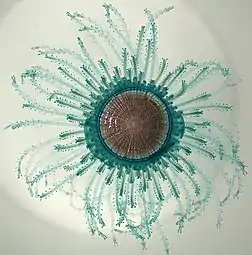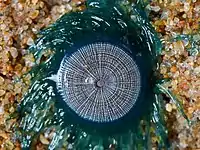Porpita porpita
Porpita porpita, or blue button, is a marine organism consisting of a colony of hydroids[2] found in the warmer, tropical and sub-tropical waters of the Pacific,[3] Atlantic, and Indian oceans, as well as the Mediterranean Sea and eastern Arabian Sea.[4] It was first identified by Carl Linnaeus in 1758, under the basionym Medusa porpita.[5][6] In addition, it is one of the two genera under the suborder Chondrophora, which is a group of cnidarians that also includes Velella.[7] The chondrophores are similar to the better-known siphonophores, which includes the Portuguese man o' war, or Physalia physalis. Although it is superficially similar to a jellyfish, each apparent individual is actually a colony of hydrozoan polyps. The taxonomic class, Hydrozoa, falls under the phylum Cnidaria, which includes anemones, corals, and jellyfish, which explains their similar appearances.
| Porpita porpita | |
|---|---|
 | |
| Blue button | |
| Scientific classification | |
| Kingdom: | Animalia |
| Phylum: | Cnidaria |
| Class: | Hydrozoa |
| Order: | Anthoathecata |
| Family: | Porpitidae |
| Genus: | Porpita |
| Species: | P. porpita |
| Binomial name | |
| Porpita porpita | |
Description

_Blue_button_at_Thotlakonda_Beach_06.JPG.webp)
The blue button can grow up to 30 mm in diameter[7] and lives on the surface of the sea and consists of two main parts: the float and the hydroid colony. The hard golden brown float is round, almost flat, and about one inch wide. The float organ is responsible for the organism’s vertical movement[5][8] and also contains pores that are able to communicate with other P. porpita organisms as well as its surroundings.[9] The hydroid colony, which can range from bright blue turquoise to yellow, resembles tentacles like those of the jellyfish.[10] Each strand has numerous branchlets, each of the knobs of stinging cells called nematocysts terminates at the distal end. The blue button has a single mouth located beneath the float, which is used for both the intake of prey and the expulsion of wastes. The mouth is surrounded by a ring of gonozooids and dactylozooids.[6] Tentacles are only found on the dactylozooids, which exist furthest away from the mouth, towards the outer part of the hydroid colony.[4]
Habitat and Feeding
_Blue_button%252C_found_on_Uttorda_Beach%252C_Goa%252C_India.jpg.webp)
The blue button is a part of the neustonic food web, which covers the organisms that inhabit the region on or near the surface of the ocean. This is because it is a passive drifter, which means that it relies on water currents and wind to carry it through the ocean. It is preyed on by the sea slug Glaucus atlanticus (sea swallow or blue glaucus) and violet sea-snails of the genus Janthina.[11] Unlike Velella, which prefers a passive diet, Porpita will hunt active crustaceans like crab and fish.[12] It competes with other drifters for food and mainly feeds on copepods and crustacean larvae.
Commensalism Between Porpita porpita and Caranx malabaricus
Young Caranx malabaricus, also known as the ‘Malabar jack’ or ‘Malabar kingfish’, have been shown to take shelter underneath the floats of Porpita porpita. Interestingly, when removed from its host, the fish will panic. These juvenile fish also appear to show preference for a particular siphonophore. When two pairs of Porpita porpita and Caranx malabaricus are separated by species, then returned to the same tank, the juvenile fish will return to their respective partners, even when forcibly separated from it.[13]
Effects of global warming on the distribution of Porpita porpita
The blue button sting is not powerful but may cause slight irritation to human skin.[2][14] However, in recent years, it has been hypothesized that due to global warming, Porpita pacifica (another name for the species)[15][6] colonies have begun appearing in larger numbers along coastlines in Japan and the first case of contact dermatitis from this species was recorded.[16] A sudden increase in the abundance of Porpita porpita has also been observed in a separate study of its populations in the Ionian and Adriatic seas, possibly also due to rising temperatures throughout the oceans.[17]
References
- WoRMS (2011). Schuchert P (ed.). "Porpita porpita (Linnaeus, 1758)". World Hydrozoa database. World Register of Marine Species. Retrieved 2011-12-18.
- "Blue Button Jellyfish (Porpita porpita) blue jellyfish with fringe". www.beachhunter.net. Retrieved 2020-04-13.
- Meinkoch, Norman. "The Audubon Field Guide to North American Seashore Creatures." 1981. New York, New York.
- Gul, Shahnawaz & Gravili, Cinzia. (2014). On the occurrence of Porpita porpita (Cnidaria: Hydrozoa) at Pakistan coast (North Arabian Sea). Marine Biodiversity Records. 7. 10.1017/S1755267214000189.
- Lillo, Antonio & Tiralongo, Francesco & Tondo, Elena. (2019). New Records of Porpita porpita (Linnaeus, 1758) (Cnidaria: Hydrozoa) in the Mediterranean Sea. Natural and Engineering Sciences. 4. 293-298. 10.28978/nesciences.646425.
- Calder, Dale. (2010). Some anthoathecate hydroids and limnopolyps (Cnidaria, Hydrozoa) from the Hawaiian archipelago. Zootaxa. 2590. 10.11646/zootaxa.2590.1.1.
- Deidun, Alan. “NOTES ON THE RECENT OCCURRENCE OF UNCOMMON PELAGIC ‘JELLYFISH’ SPECIES IN MALTESE COASTAL WATERS.” Naturalisa Siciliano, vol. 4, no. 34, ser. 3-4, 2010, pp. 375–384. 3-4.
- Fryer G, Stanley GD (2004) A Silurian porpitoid hydrozoan from Cumbria, England, and a note on porpitoid relationships. Palaeontology 47(5):1109–1119
- Chowdhury, M. Shah Nawaz; Sharifuzzaman, S. M.; Chowdhury, Sayedur Rahman; Rashed-Un-Nabi, Md.; Hossain, M. Shahadat (2016-06-01). "First Record of Porpita porpita (Cnidaria: Hydrozoa) from the coral reef ecosystem, Bangladesh". Ocean Science Journal. 51 (2): 293–297. doi:10.1007/s12601-016-0025-9. ISSN 2005-7172. S2CID 89423938.
- "Identification Chart for Jellies." Archived 2009-02-21 at the Wayback Machine
- Hayward P.J. & Ryland J.S. (1990). The Marine Fauna of the British Isles and North-West Europe. Volume 2 - Molluscs to Chordates. page 681. Clarendon Press, Oxford. ISBN 0-19-857515-7
- Saygın, Özlem. (2017). On the occurrence of blue button, Porpita porpita (Cnidaria: Hydrozoa) from Levantine coast of Turkey. Natural and Engineering Sciences. 2. 33-36. 10.28978/nesciences.328905.
- Noble A.(1963) Association between the fish, Caranx malabaricus Cuv. &Val. and the siphonophore, Porpita pacifica Lesson. Journal of theMarine Biological Association of India 5, 142–143.
- Ramanibai, R., Govindan, S. & Balakrishnan, T. (2014). Notes on the occurrence of Porpita porpita (Blue button) from Pulicat Lagoon. Journal of Research in Biology 4(7): 1487-1490.
- WoRMS Editorial Board (2020). World Register of Marine Species. Available from http://www.marinespecies.org at VLIZ. Accessed 2020-03-30. doi:10.14284/170
- Oiso N, Fukai K, Ishii M, Ohgushi T, Kubota S. Jellyfish dermatitis caused by Porpita pacifica, a sign of global warming? Contact Dermatitis. 2005 Apr;52(4):232-233. DOI: 10.1111/j.0105-1873.2005.0566f.x.
- Bianchi, C.N. (2007). "Biodiversity issues for the forthcoming tropical Mediterranean Sea". Hydrobiologia, 580: pp.7-21.
| Wikimedia Commons has media related to Porpita porpita. |